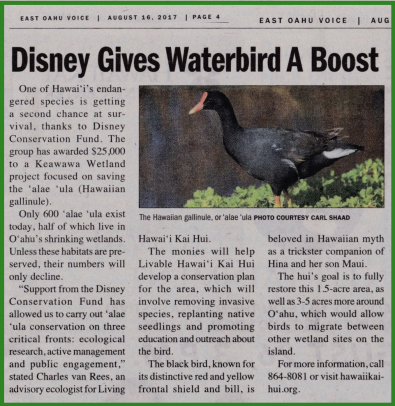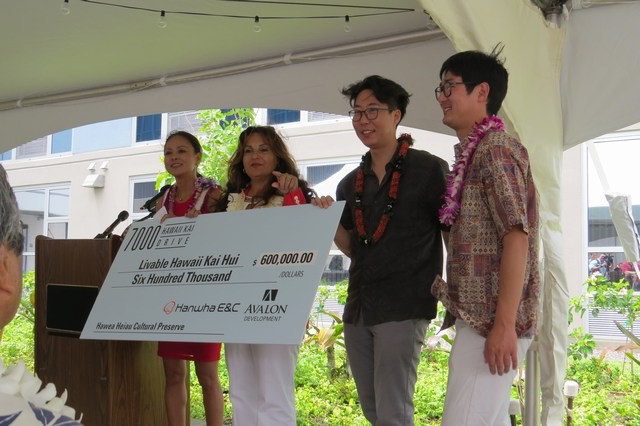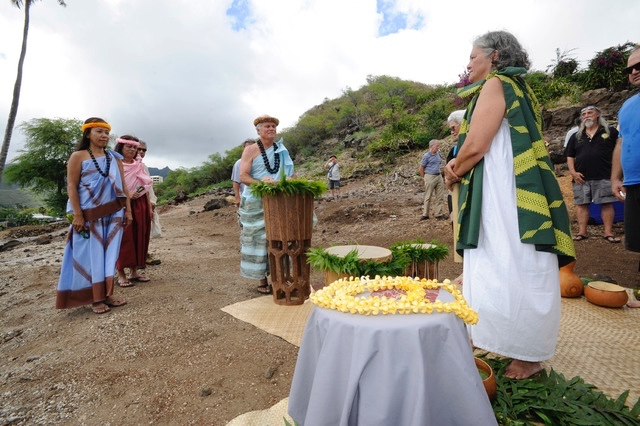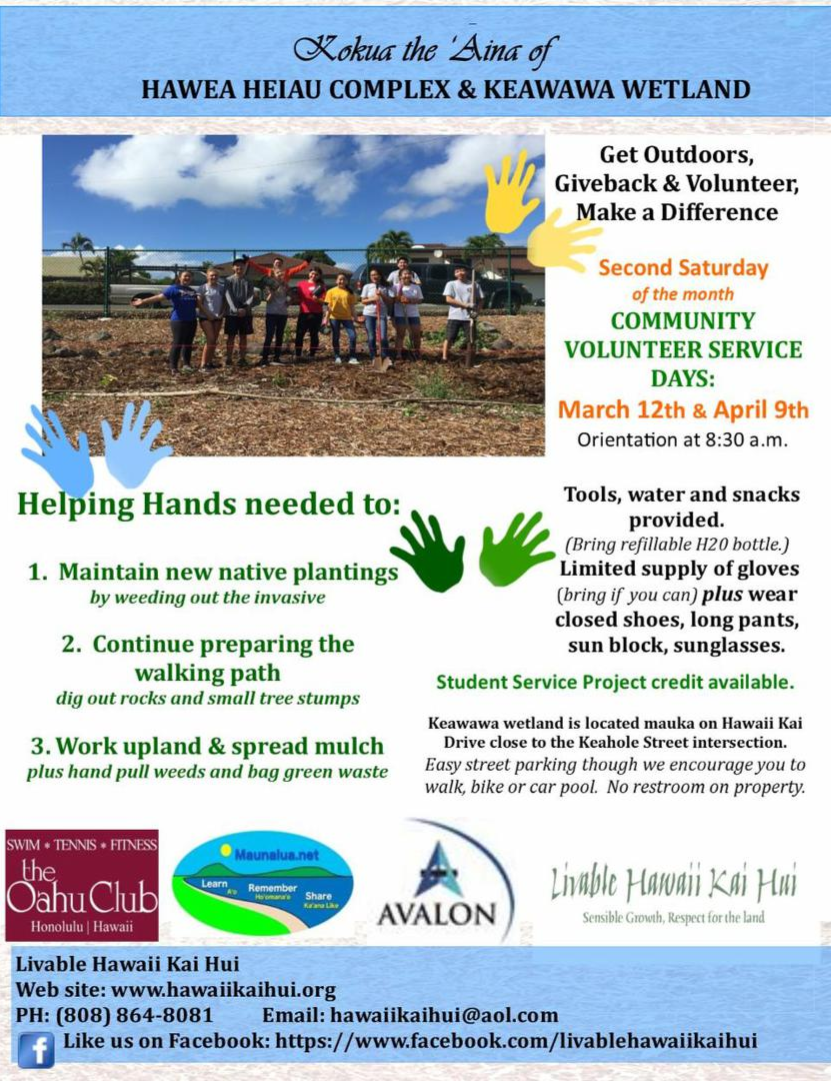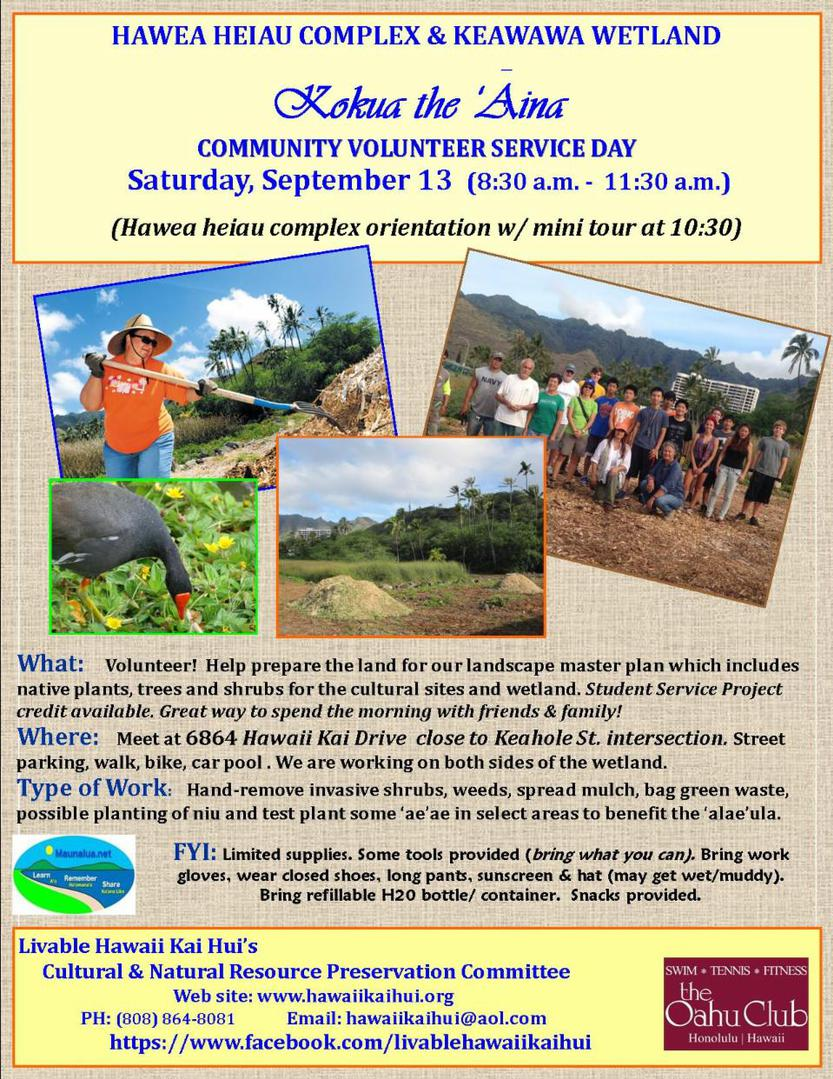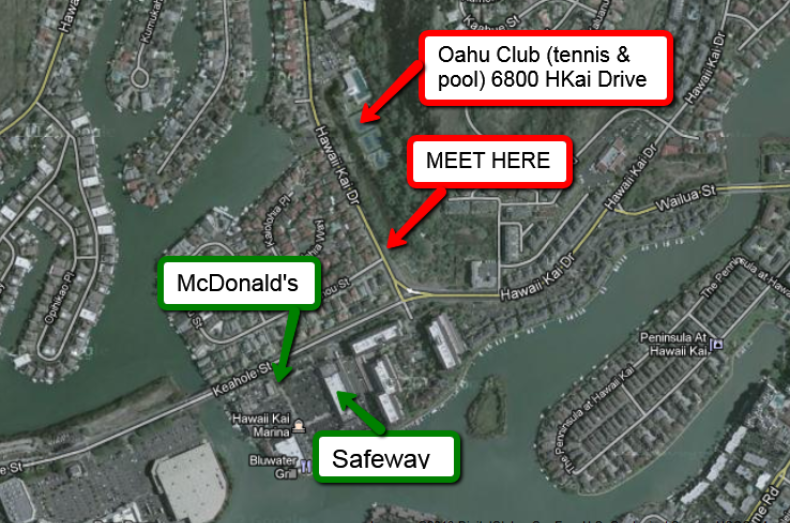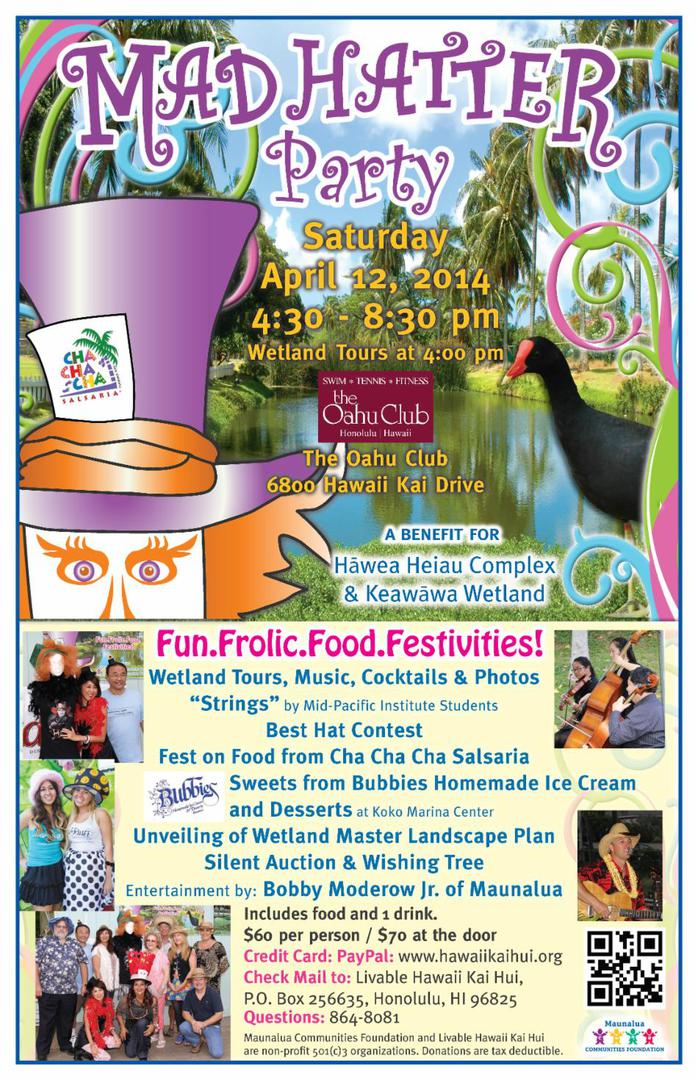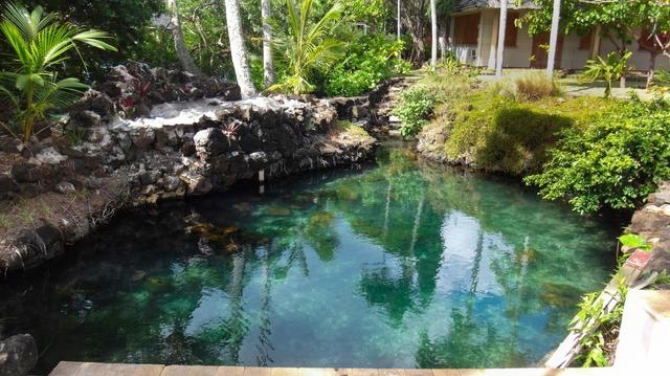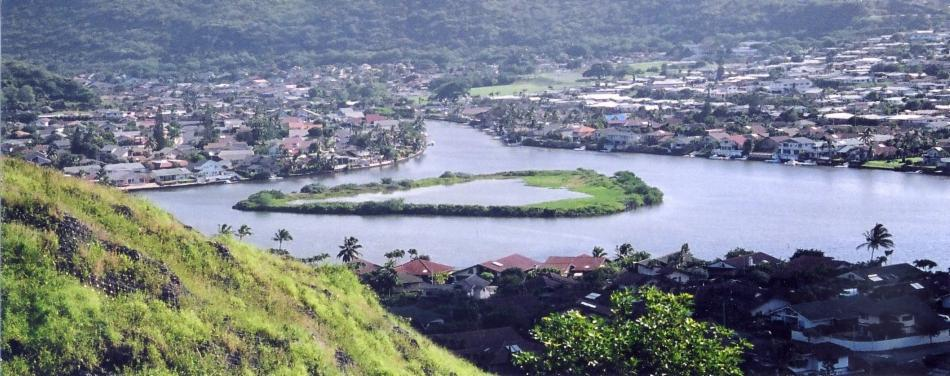
KEAWAWA WETLAND
2-2-19 Celebrate World Wetlands Day at Keawawa wetland starting with with 9 a.m. pule (Mahi LaPierre). Enjoy a morning of hula (Halau Hula Kalehuapuakea), planting native plants, walking tour, alae’ula watching, short lectures (Annette Tagawa on the oape ‘ula and Maunalua.net, cultural talk-story), refreshments, door prizes and free T-shirts to volunteers who malama the aina with us for an hour (while supplies last).
October 13th volunteering was on The Oahu Club side. We had 15 folks. Lots to set up and breakdown as well as educate while folks worked. Students from KCC, KS, Punahou and St Lois showed up plus area residents. Most were repeats! Many thanks- Elizabeth
September 8th, 2018 Second Saturday Wetland Workday
9-4-18 Charles Van Rees article about wetland conservation was just published in 'Elepaio. It discusses Keawawa wetland. http://www.hawaiiaudubon.org/elepaio-journal
FEBRUARY 3rd, 2018 - WORLD WETLAND DAY PHOTOS
What an amazing day with amazing volunteers from Aulani Resort! Mahalo for all you did to help make our event successful and fun. We have greatly enjoyed the opportunity to meet you all and make our community more sustainable and livable!
Adobe Acrobat document [937.5 KB]
Above: Aleula Chicks
On the right: One of our volunteers pulls weeds at the Oahu Club side of the property.
Livable Hawaii Kai Hui, your land steward for Keawawa Wetland on Hawaii Kai Drive, seeks volunteers to come and work independently pulling weeds, watering and caring for the land. We will provide gloves, tools, and a free T-shirt. Contact the hui at:
hawaiikaihui@aol.com if you are interested. Thank You!
9-28-16 Mark your calendar! Come on down to Mud Hen Water next week Wednesday, 9/28 5-7pm. Come and join the celebration at a cocktail mixer where you can mingle with local biologists to learn about efforts to recover the alae ula, found only in Hawaii, and learn about the restaurant's link to this special bird." In particular, this benefit will support the research being conducted by our very own advisor, Charles Van Rees and the Keawawa Wetland.
9-24-16 - Cub Scout Pack 101 at Hawea Heiau Complex and Keawawa Wetland
Livable Hawaiʻi Kai Hui was presented with a check from Hanwha E & C and Avalon for $600,000 to further the work of preserving Hāwea and Keawāwa.
These monies had previously been given to the Hui and had assisted in funding work that had been done up to this time and will provide funds for stewardship into the future. Mahalo!
STAR ADVERTISER MAY 15, 2016
Once the 112-foot-tall apogee of an imperiled cultural heritage site and the most popular tree in the United States, “Coco” the coconut palm tree returned to Hawea Heiau on Sunday in a new form and with renewed significance for the surrounding community.
About two dozen organizers, volunteers and community members were on hand at the heiau, located off the intersection of Hawaii Kai Drive and Keahole Street, where educator and artisan Brad Cooper presented a specially crafted pahu (drum) made from the celebrated coconut tree to the Livable Hawai‘i Kai Hui, the organization responsible for preserving the nearly forgotten heiau.
“This is an example of how things can be achieved if it is done with good intentions and is positive for all,” said Kaleo Paik, a member of the Livable Hawai‘i Kai Hui.
In 2014, COCO was voted the most popular big tree in the country by readers of American Forests magazine. Months later, however, high wind sheared the crown off the tree, assuring its eventual demise.
By chance, Paik found herself on the same interisland flight with Cooper. After learning of the tree’s plight, Cooper volunteered to visit the site to see whether wood from the tree might be salvaged to craft a drum.
Ultimately, Cooper, Sam Camp, Jean Raser, Sonny Kaulukukui, Miki Lee and a couple of forklift operators from Hawaiian Dredging Construction Co. were able to bring the tree down without damaging any of the surrounding archaeological structures.
Cooper cut a portion of the base and over the course of five months crafted a unique tribute to both the site and to the legendary origins of coconut drums in Hawaii. The cutaway designs on Cooper’s pahu represent the hull of the canoe that the Tahitian voyager La‘amaikahiki used to travel to Hawaii, bringing with him for the first time a kaeke (temple) drum.
The drum was completed with elk skin drawn tight with sennit cords dating from 1932.
Seven other sections cut from the tree were given to local halau to craft their own drums. It’s hoped that once each group has finished their work, all will return to the site to play the instruments together.
Sunday’s gifting ceremony included chants, a traditional awa ceremony and purification rites, all part of a protocol to demonstrate pure intent.
The presentation of the pahu, dubbed Kaniala‘a, was particularly resonant given the contested history of the site, which was originally set aside for use as a parking lot and private park for the adjoining Hale Ka Lae (formerly Hale Ali‘i) condominium.
Livable Hawaii Ka‘i Hui intervened on behalf of community members who wished to prevent the destruction of the heiau, which contains petroglyphs and other features dating from its former existence as a pre-contact Hawaiian village. As part of an organized protest, the hui organized a “drumming” at the site in 2009.
In 2010 the group negotiated with the condominium’s new owner, Hanwha Engineering and Construction, to purchase the 5-acre site for $650,000.
In the years since, the group has overseen a massive clearing and restoration of the area. Future plans call for the construction of a traditional hale and storage for artifacts discovered at the site.
“There are no words that can competently express what it means to complete this process and achieve the dream we shared all those years ago,” Paik said.
5-1-16
COMMUNITY VOLUNTEER JULY 12TH, 2014 (Click the PDF below)
Adobe Acrobat document [937.5 KB]
3-20-14 NONPROFIT PRESERVES HAWAII KAI WETLANDS http://www.kitv.com/news/local-nonprofit-preserves-hawaii-kai-wetlands/25084196
MAD HATTER GARDEN PARTY AT THE OAHU CLUB APRIL 12, 2014 SCROLL DOWN FOR MORE INFORMATION.
Wetland workday #16 below.
Mad Hatter
Party
April 12, 2014 | 4:30 to 8:30 PM
The Oahu Club, 6800 Hawaii Kai Drive, Honolulu 96825
$60 per person/$70 at the door ($30 is tax-deductible) $10 off ticket if purchased prior to 3/10
Casual dress with fun, expressive hats
Includes: Music by Bobby Moderow Jr., Strings by Mid-Pacific Institute students,
Festive food from Cha Cha Cha Salsaria
Fun desserts from Bubbies Homemade Ice cream & Desserts (Koko Marina Center)
Prizes for best hats, silent and live auction, door prizes, wetland tours, and more
HAWAII KAI – A fundraiser at The Oahu Club will benefit community conservation project in East O’ahu. Recipient of the fund raising is Livable Hawaii Kai Hui (Hui) and its ongoing Keawawa Wetland and
Hawea Heiau Complex community project. The Hui’s goal is to restore the wetland and enhance the ‘Alae’ ula habitat, which includes the reintroduction of native plants along 1.5 acres of Keawawa
wetland at The Oahu Club and continues on 5-acres of the neighboring property where Hawea heiau complex is situated upland. Over the past year, the Hui removed over 346 invasive trees and
shrubs.
Mardi LaPrade, an Oahu Club member, first noticed the ‘Alae’ula several years ago and has since worked with the Livable Hawaii Kai Hui to establish appropriate oversight partnerships to help with
conservation planning including wetland delineation of the area and the development of educational and community-based kokua programs. LaPrade noted that “according to the 2005 Fish and Wildlife
report, there are estimated 300 to 400 ‘Alae ‘ula in the world, inhabiting only O’ahu and Kauai”. Because of this, the restoration and maintenance of this little wetland would greatly benefit this
species.
The first Mad Hatter Party in 2011 benefited Hui’s efforts to bring awareness to the wetland area. Since, several local businesses including The Oahu Club, Bubbies Homemade Ice cream & Desserts
at Koko Marina Center, Cha Cha Cha Salsaria, Riches Kahala at Kahala Mall, Hawaii Kai Jaycees and Maunalua Communities Foundation stepped up to help coordinate this annual event as a way of giving
back to community while helping this non-profit achieve its conservation and public education goals. The Hui plans to unveil a preliminary master landscape plan for the wetland at the event.
Strings by Mid-Pacific Institute students kick off the festivities and Bobby Moderow Jr. of Maunalua performing later in the evening. Guests are asked to wear their finest chapeau decked out in
creative finery. A contest will choose a People’s Choice winner for best fun or favorite design. Silent auction items are now being accepted.
Persons interested in volunteering for the event may contact Dianne Glei, 224-8357. Tickets are available at www.hawaiikaihui.org through PayPal or mail check to Livable Hawaii Kai Hui, P.O. Box
25493, Honolulu, Hawaii 96825.
Keawawa is a spring-fed estuarine wetland. Estuarine wetlands occur where freshwater meets the ocean, and the resulting brackish system is a nursery ground for young fish and shellfish, which are
prey species for native birds and coastal fisheries. Keawawa wetland provides habitat for indigenous ‘auku‘u (black-crowned night heron), endemic pinao (giant green darner dragonfly), various species
of native damselflies, endangered ae‘o (Hawaiian stilt), and 3-9 of the estimated 300 to 400 remaining endangered ‘alae ‘ula (Hawaiian moorhen). According to USFWS, ideal habitat for ‘alae ‘ula is
dense emergent vegetation near open water with shallow water depths and fresh water. Keawawa wetland provides such a habitat and the ‘alae ‘ula now have approximately 2 broods of chicks there per
year. The ‘alae ‘ula have not been documented at Keawawa wetland in recent US Fish and Wildlife Service Surveys (USFWS Recovery Plan had no record of ‘alae ‘ula in the area from 1999-2003) but kupuna
(elders) of the area speak of their steady presence at Keawawa fishpond in the
past.
February 8th - Workday 14 at Keawawa Wetland & Hawea Heiau Complex. Your kokua is
appreciated.
April 12, 2014 is the annual Mad Hatter Garden Party at the Oahu Club to benefit the Keawawa wetland community project- we hope you consider
attending.
1-11-13 Start the New Year Giving Back to Community!
Join us on January 11th for a look around Hawea Heiau Complex & Keawawa Wetland and get an update on this unique community project or stay and volunteer! See flyer below... Cheers to You!
PS: Your thoughtful donation to Livable Hawaii Kai Hui will go directly to supporting our community projects. By making a gift today, you will help Livable Hawaii Kai Hui provide the resources and support that drive our community cultural and conservation movement forward. Show the importance of cultural & land conservation in our community by making a gift today.
Livable Hawaii Kai Hui is a 501(c)(3) organization and any amount you donate before December 31 may be deductible for 2013 income tax purposes. Please see your tax advisor for actual deductibility.
Donate Now: www.hawaiikaihui.org Livable Hawaii Kai Hui PO Box 25493, Honolulu, HI 96825
Workday 12 below (Click PDF below)
Adobe Acrobat document [937.5 KB]
Next workday is Oct. 12, 2013 click her for more information - WORKDAY 10 9 (Click PDF below)
Adobe Acrobat document [656.0 KB]
9-14-13 - workday 9 and community open house at Hawea Heiau Complex.
Next community open house/work day. PDF links are provided so you may familiarize yourself with our project.
Adobe Acrobat document [559.7 KB]
Adobe Acrobat document [1.4 MB]
Adobe Acrobat document [1.8 MB]
4-20-13 - Food, Fun, Frolic, Fantastic Festivities... Save the date for the Mad Hatter Garden Party II on April 20th at the O'ahu Club to benefit two community projects. And don't forget to kokua the 'aina at Hawea Heiau Complex and Keawawa Wetland in Maunalua this Saturday, February 9th from 8:30 to noon. There's lots to do and you're needed, so see you there!Mad Hatter Garden Party II
2-9-13 Join us Saturday, 8:30am - noon and also on every Second Saturday of Each Month at Keawawa Wetland & Hawea Heiau Complex for a Community Open House and Workday. Special thanks to Kaleo Paik for her leadership and guidance! Kaleo has graciously offered to host the February 9th community open house and workday. If you need to reach Kaleo, please call 354-7765.
2012
Rim Island No.2 Update - Hawaii Kai Marina
Henry J. Kaiser started the development of Kuapa Pond, in the late 1950’s. It was done in accordance with customs and laws of that day. The result became the
community of Hawaii Kai, one of Oahu’s finest residential developments. The 523 acre Kuapa Pond, a fishpond and wetland, was converted to a 240 acre Hawaii Kai Marina. However; no provision was made
for the loss of the wetland habitat which had been home to hundreds of native Hawaiian water birds and other migratory species. During the dredging of the Marina two doughnut shape islands were
created on the old Kuapa Pond and wetlands for future disposal of dredge material from maintenance dredging. These Islands were designated as Rim Island No.1 and Rim Island
No.2.
In 1996 Dredging Project of the Marina was carried out by the Hawaii Kai Marina Community Association, the owner of the Hawaii Kai Marina however; no environmental planning was done. Rim Island No.1 was partially filled and the contractor placed dredge material in a haphazard manner on Rim Island No.2. As a result a wetland was created in Rim Island No. 2 and it is believed the endangered Hawaiian Stilt, Ae’o, shortly returned to Hawaii Kai Marina to reside in Rim Island No. 2. The Ae’o was first recorded on Rim Island No.2 in 2001. The next year, an Ae’o nest with eggs was found by a Marina Patrolman. For the next ten years a number of discussions took place between the Marina Association and environmentalists.
The Marina Association wanted to continue using Rim Island No.2 as a dredge disposal site. There were numerous meetings with federal and State agencies that had jurisdiction over dredging and endangered species. Many talks took place with the community over the future of Rim Island No.2. In 2011 the Hawaii Kai Community Marina Association finally recognized in the State of Hawaii Final Environmental Assessment that Rim Island No. 2 would remain a habitat for the endangered Hawaiian Stilt, the Ae’o. It is one of a few nesting sites for the Ae’o from Pearl Harbor to the Windward side.
11-2-12 FACT SHEET The Trust for Public Land - Hāwea Heiau Complex & Keawawa Wetland
The Trust for Public Land is working with a non-profit community
organization Livable Hawai‘i Kai
Hui (The Hui) to protect a 5-acre property in heavily-developed Maunalua, O‘ahu. The property
includes Hāwea heiau complex and a portion of Keawawa wetland. The property contains numerous
petroglyphs, an ancient niu (coconut) grove, a once spring-fed well, and many ancient rock formations
thought to be house structures, a Tahitian style heiau, agricultural terraces, burial sites, and Hāwea
heiau. Oral and written accounts from 8 centuries ago reflect the importance of Hāwea heiau as one of
the places that La‘amaikahiki’s canoe landed carrying with it one of only two pahu heiau (religious
drums) – Opuku and Hāwea – used ceremonially at the royal birthing grounds of Kūkaniloko, in the
piko (center) of O‘ahu. Keawawa wetland is home to approximately 9 of the remaining 300
endangered ‘alae ‘ula (Hawaiian moorhen), as well as indigenous ‘auku‘u (Black-crowned night heron),
pinao (Hawaiian dragonfly), and possibly the ‘ōpe‘ape‘a (Hawaiian hoary bat) that historically lived in
the area.
The Hui’s goal is to protect, restore and mālama (take care of) Hāwea heiau complex and Keawawa
wetland, and to create a cultural renaissance within Maunalua through community education of the
cultural and natural resources located on the property. The Hui preliminarily envisions a small entrance
space where visitors can learn about the area’s importance before entering, the restoration and
preservation of all cultural sites, an environment dominated by native species, a pā pahu (pahu
drumming area), a fishing hale, a la‘au lapa‘au (healing and medicinal plant) garden, and a thriving
native wetland ecosystem that provides additional protected habitat and nesting grounds for the
endangered ‘alae ‘ula and other native species. The property will be a community owned and managed
cultural heritage park that will provide educational, cultural, and recreational opportunities to the
Maunalua community and the broader public.
The Trust for Public Land is working with county and state partners to
raise approximately $650,000
for the acquisition on behalf of The Hui, and to handle all transactional
responsibilities:
State Legacy Land Conservation Program:
$325,000 (funding released)
County Clean Water and Natural Lands Fund: $325,000 (funding released)
Contact: Laura Ka‘akua, Native Lands Project Manager, (808)
524-8562,laura.kaakua@tpl.org
9-22-12 workday #2 information below
8-18-12 Wetland Work Day and results ! (See PDF below)
Adobe Acrobat document [332.7 KB]
10-5-11 Luxury Condos in Hawaii Kai and protection of neighboring wetland habitat and heiau !
7-31-11 Honolulu Star Advertiser Article - HEIAU ABIDES HIGH-RISE - A developer and a community group collaborate to accommodate the old and the new in Hawaii KaI http://www.staradvertiser.com/specialprojects/2011/progress/20110731_progress_heiau_abides_high_rise.html
5-24-11 Congratulations to the Livable Hawaii Kai Hui for their successful efforts with the Trust for Public Land to preserve the Hawea Heiau Complex and the Keawawa Wetland for the benefit of the Maunalua community, the public and future generations. Mahalo a nui loa no ka 'oukou hana po'okela! (Thanks to you all for your outstanding work!)
NEW VIDEO POSTED ON YOU TUBE "A WORD WITH WARD" - INTERVIEW WITH LIVABLE HAWAII KAI HUI /WETLAND COMMITTEE - be sure to click on part 2 and part 3! www.youtube.com/watch?v=_26crMpZ_K0
3-5-11 Mad Hatter Garden Party at the Oahu Club
3-5-11 FUNDRAISER AT THE OAHU CLUB
March 5th - Mad Hatter Garden Party at the O'ahu Club Community group holds event for endangered wetland bird.‘Alae’ula found nesting in Hawaii Kai: 3:30 to 6:30 PM at The Oahu Club, Hawaii Kai Drive, Honolulu 96825 Price: $20 per person, Casual dress w/fun, expressive hat. Includes: Music by Jive Nene, Ono Pasta Bar, Guest Speakers, Door Prizes! HAWAII KAI Community group Livable Hawaii Kai Hui together with The Oahu Club will hold a fundraiser to help with restoration efforts to improve the wetland habitat located in Hawaii Kai off Hawaii Kai Drive. Keawawa is a spring-fed estuarine wetland. Estuarine wetlands occur where freshwater meets the ocean, and the resulting brackish system is a nursery ground for young fish and shellfish, which are prey species for native birds and coastal fisheries. Keawawa wetland provides habitat for indigenous ‘auku‘u (black-crowned night heron), endemic pinao (giant green darner dragonfly), various species of native damselflies, endangered ae‘o (Hawaiian stilt), and 3-9 of the estimated 300 to 400 remaining endangered ‘alae ‘ula (Hawaiian moorhen). According to USFWS, ideal habitat for ‘alae ‘ula is dense emergent vegetation near open water with shallow water depths and fresh water. Keawawa wetland provides such a habitat and the ‘alae ‘ula now have approximately 2 broods of chicks there per year. The ‘alae ‘ula have not been documented at Keawawa wetland in recent US Fish and Wildlife Service Surveys (USFWS Recovery Plan had no record of ‘alae ‘ula in the area from 1999-2003) but kupuna (elders) of the area speak of their steady presence at Keawawa fishpond in the past. Livable Hawaii Kai Hui is a 501(c)(3) non-profit corporation and nonpartisan community action group serving East Honolulu since 2004. The Hui’s mission is “...to encourage grass roots organization, community awareness and education of laws, rules and regulations that guide sensible growth and development to enhance the quality of life for residents, focusing on the preservation of the agricultural lands in Kamilo Nui Valley, natural watersheds and adequate open spaces and community stewardship for the protection of watersheds, wetlands, natural and scenic resources and cultural and historic areas in East Honolulu.” The Hui's most recent accomplishment involved working with the State Office of Planning to change the makai lands of the Ka Iwi coast from urban to conservation. Another key milestone in the Hui's development has been the launch of the Aloha 'Aina o Kamilo Nui educational program, which promotes community agriculture in Maunalua.
Microsoft Word document [51.0 KB]
Adobe Acrobat document [781.3 KB]
2-19-11 - Wetland Clean Up: We will do the inner bank clean up which is removal of tennis balls in the pond using small nets and help with hand hauling cut branches to mulch (machine located outside the gate). Tree trimming is top priority in certain areas to help protect the young chicks from predator birds hovering above. We suspect a schedule of 8:00 - 12 noon which includes the first 30 minutes for orientation. Refreshments will be provided. Please confirm if you can help - one or two hours makes a difference especially if you bring a family member or friend. - Elizabeth Reilly - 808.864.8081- Livable Hawaii Kai Hui
TEA PARTY CANCELLED .... QUESTIONS? - CALL 864-8081
10-25-10 MAD HATTER TEA PARTY AT THE OAHU CLUB IN HAWAII KAI - 'ALAE'ULA NESTING AREA
Mad Hatter Tea Party, a gathering to benefit the Hawai'i Kai wetland project at The O'ahu Club.
RSVP to Kaumaka Wong at kaumakawong@yahoo.com or
#221-0555 by
Cost - $15.00 per person (bring your own tea cup)
Sport a big, colorful, expressive hat or just your ole' favorite. Bring your own tea cup and join us for a talk story, a silent auction, tasty finger sandwiches, decadent sweets, complimentary wine
and more...
Come learn about the history and restoration efforts of our wetland project and the rehabilitation of the endangered 'Alae'ula nesting grounds.
A benefit to raise funds for Livable Hawaii Kai Hui's wetland restoration project in partnership with the Oahu Club.
Sponsored by Livable Hawaii Kai Hui, Maunalua Fishpond Heritage Center, Maunalua.net, and The Oahu Club.
Check Payable to Livable Hawaii Kai Hui
Mail to: Livable Hawaii Kai Hui | P.O. Box 25493 - Honolulu, HI | 96825 or PAYPAL ABOVE.
View Clear Photos of Oahu Club Wetland
Adobe Acrobat document [3.4 MB]
Adobe Acrobat document [3.4 MB]
Adobe Acrobat document [1.2 MB]
9-18-10 Volunteer information to help the endangered 'Alae'ula bird's habitat at the Oahu Club in Hawaii Kai
Dear Volunteers,
Thank you so very much for planning to give your time this Saturday morning the 18th of September to work on the clean up of the endangered 'Alae'ula bird's habitat at the Oahu
Club in Hawaii Kai.
We will begin at about 8:15 with a short orientation. The Livable Hawaii Kai Hui will provide water, juice, snacks, and at the end of the morning, pizza.
If you arrive late or need to leave early please see Todd for a one on one introduction.
Please also know we will be taking photos throughout the day as well as a group shot.
There
are some important guidelines we at the Hui would like you to follow.
First, please feel free to take a break, sit down, get some refreshments as you feel the need. There are clean bathrooms readily available near the pond at the club facility.
***Please wear sunscreen, work gloves, and covered shoes. I suggest sunglasses. You might want a hat.
We will organize as we arrive but some general guidelines are that we will have only two people feeding the chipper at a time and these people will be designated. You do not necessarily have to do
this job. If you are going to be near the chipper, sunglasses or goggles are suggested since, depending on the wind there can be some dust there. If this is bothersome, you may choose to work further
away from the chipper.
Our job will be to pass the material to these designated people at the chipper. The work should go fast and actually I had a lot of fun last time feeding the chipper and sorting the coconuts.
Again, many thanks and we look forward to enjoying your company and our little bird friends seem to watch with interest. If you have not seen these endangered birds (fewer than 300 in the world) I
will be happy to introduce you! You will be helping to make their nesting habitat a safer place by removing debris that their predators hide in. Thank you!
Sincerely, Mardi (on behalf of the Livable Hawaii Kai Hui; wwwhawaiikaihui.com) If you have questions, please call my cell at 348-2847, thanks.
9-9-10 EAST OAHU SUN WETLAND ARTICLE - Hawaii Kai Hui sponsors clean up event for Oahu Club Wetland Group
5-8-10 Oahu Club Wetland Field Trip from 9AM-11AM Saturday! OAHU CLUB WETLAND FLYER
Please Come To Our Meet and Greet Sponsored by Livable Hawaii Kai Hui and the Maunalua Fishpond Heritage Center. Learn about the OAHU CLUB WETLAND! You have always know about this serene wetland area next to the Oahu Club that is located below the ancient palms at the base of Mariner's Ridge. Learn about the history and biology of this environmental treasure. It is a nesting ground of endangered `Alae `Ula. Renowned experts to speak - Mr. Ron Walker, former head of the State Division of Forestry and Wildlife and Ms. Marjorie Zieglar, President of the Conservation Council of Hawaii. Come to the Oahu Club Lawn By The Pond. Seating is limited. Please R.S.V.P. to mardilaprade@aol.com - T-shirts available in mens and womens.

Adobe Acrobat document [2.6 MB]
Download OAHU CLUB WETLAND FLYER Here
Adobe Acrobat document [1.1 MB]
PAHUA HEIAU - HAWEA HEIAU - LUCAS SPRING/MFHC (SEE BELOW)
MAUNALUA FISHPOND HERITAGE CENTER (MFHC)
This week brings awesome news about our fishpond bill. HB 1665 finally passed! Act 210 which became law this week prohibits sale of government owned Hawaiian fishponds. What an amazing effort from everyone. After two legislative sessions, countless community meetings and floods of letters our voices were heard!
The message was loud and clear. Restore and protect our ancient fishponds, don’t auction them to the highest bidder. Whether it was the hundreds of signatures collected on the petition or lobbying in the community and legislature, everyone contributed. Our legislators responded by passing the bill unanimously. Initially Governor Lingle placed it on her veto list. However, she reversed her decision at the end and allowed it to pass without signature.
What we gained was more than protection for ancient Kalauha’iha’i and Kanewai Fishpond in East Honolulu. Community education and restoration efforts now have a fighting chance without the threat of being sold as beachfront estates. Many saw the $12 million price tag that was attached to the Menehune Fishpond on Kaua’i. We know once ponds reach private hands they become really tough to recover. Thanks to all of you, our government owned Hawaiian fishponds now have the permanent protection they deserve. Mahalo nui! Chris
3-27-10 KGMB "Aha'i Olelo Ola" Pahua Heiau
 CATCHING OCTOPUS
CATCHING OCTOPUS
March 26-2010 MAUNALUA FISHPOND HERITAGE CENTER - Click on the link below to hear the public radio segment that was on today's radio. http://www.hawaiipublicradio.org/hpr/index.php?option=com_content&task=view&id=4469&Itemid=99999999
FEBRUARY 25, 2010 - Thursday 5:30 - 8:30pm, PAHUA HEIAU TALK STORY GATHERING with Office of Hawaiian Affairs. At the Mariner's Cove Bay club - 800 Lunalilo Home Rd. in Hawaii Kai. CLICK PDF TO SEE THE INVITATION.
Adobe Acrobat document [622.0 KB]
Below Read Honolulu Advertiser Article - Click Below
Adobe Acrobat document [296.5 KB]
Save Natural and Cultural Resources - PRESERVATION AND PERPETUATION OF HAWEA HEIAU COMPLEX
11-7-2009 - On Nov. 7th, 2009, people from around the world answered a simple kahea, a simple call, which asked they join us with their drums at their sacred sites as we drummed at Hawea Heiau in Maunalua. The drum, a symbol of our heartbeat, the pulse of our land. One year ago Hawea Heiau Complex was under severe threat of being erased. Media ads announced its planned conversion into a gated recreation area for a luxury development. Part of the heiau was illegally bulldozed. Without proper protection from the State Historic Preservation Division, Hawea's fate seemed sealed with each new survey spike. Then, across the oceans the call was heard. People used drums, ipu, pahu, ohe pu, or simply the gentle tapping of their hand over their heart. Our heartbeats worldwide were united together under one beat for our kupuna and our sacred sites.
The incredible mana, the power, that was created by all of us worldwide that night was the beginning of something we could never have imagined. We have the chance now to complete what was started by saving Hawea Heiau Complex, and renewing this cultural piko of Maunalua. We have the opportunity to preserve, restore, steward, educate and perpetuate this priceless cultural treasure in perpetuity for generations to come. Members of the Livable Hawai'i Kai Hui, the Maunalua Fishpond Heritage Center, Aloha Aina O Kamilo Nui and Maunalua.net have been working with the new development team for the condominium project for the past 6 months to do what is culturally appropriate and pono for the preservation and perpetuation of Hawea Heiau Complex.
The Livable Hawai'i Kai Hui has entered in partnership with the Trust for Public Lands to acquire the 5 acre parcel where Hawea Heiau Complex and Keawaawa wetlands are located from the developer. The new developer has recognized how important this cultural site is to our community; Hawaiian and non-Hawaiian. The Livable Hawai'i Kai Hui and the Trust for Public Lands ask for your immediate help. We need your voice to be heard in support of this project.
What to do? We ask you send a simple email to us saying you support this effort. If you are writing from an organization or civic club, please let us know who your group is and that you support this effort for the Hawea Heiau Complex.
Please remember to include your name on your email. We need to collect these on or by this Wednesday, October 27th. Mahalo.The emails we collect will be presented to those who will help the Trust for Public Lands and the Livable Hawai'i Kai Hui in the funding process.
What to write? Here's an example: To Whom It May Concern: I support the preservation and acquisition of the 5 acre parcel of Hawea Heiau Complex and Keawaawa Wetlands by the Trust for Public Lands and the Livable Hawai'i Kai Hui.And I support their efforts as they work to attain funding from Legacy Lands and the Clean Water and Natural Lands to acquire this most important cultural sitein perpetuity for the people of Hawai'i.
AUGUST - 2009 - Senator Clayton Hee visits Hawea Heiau with LHKH - HEE PRESS RELEASE, CLICK PDF BELOW
Adobe Acrobat document [38.1 KB]
JUNE - 2009 The bulldozing and desecration of Hawea Heiau in Maunalua (Hawai'i Kai) is a travesty. Our community is both sad and angry. Where is the respect for our wahi pana (sacred places) and our kupuna? How can we all come together to save the iwi and archeological features that call to us for This is the beautiful site of ancient swaying palm trees that were once a Hawaiian Fishing Village before Hawaii Kai was built. It is next to the Oahu Club and Hawaii Kai's last major residential project called Hale Alii.. The newscast reflects how awful it was that the developer just bulldozed Hawea Heiau which is part of this site. For more information on Hawea Heiau please click on the menu item to the left that is "Nat'l and Cult Resources".
Update on Hawea Heiau June 16, 2009.City & County - The City of County of Honolulu is investigating multiple violations by the developer on the grounds of Hawea. As this investigation is going on, no work is allowed to take place at Hawea. Our community found out today via the City Inspector that the developer did not have a permit to do the work which has taken place. The developer told the City inspector, "he didn't know he needed a permit." This is a temporary halt of work while the investigation is conducted. The developer can apply for needed permits after the investigation is completed. However, this is good news for now. State - DLNR is also investigating possible violations which have taken place at Hawea. State Historic Preservation Dept. (SHPD) - Our community received the agreement between SHPD and the developer today, June 16, 2009. A copy of this agreement was supposed to have been shared with the community before any work was done per information provided by the SHPD office. This new agreement was dated May 11, 2009. The bulldozing at Hawea, with no permit, took place soon after this date. Had our community members, cultural experts and archeologists been given this agreement to review, we would have asked for an immediate halt to the agreement. Only a small portion of Hawea is protected in this current agreement. Protection is not given to numerous identified cultural sites at Hawea. Due diligence and clear documentation must be conducted by ALL parties involved regarding Hawea Heiau immediately. Please continue to email and call our government officials to ask them to stop the destruction of Hawea Heiau. Your voice is making a difference. Will keep you updated. Aloha, Ann Marie
MAUNALUA FISHPOND HERITAGE CENTER
MAUNALUA BAY (KHNL) - During the 1950s, the Kalauhaehae Fishpond was one of the greatest fisheries in Honolulu, pumping out around 200,000 gallons of fresh water a day. A non-profit center wants to restore it back to its golden days. The pond in Niu Valley in east Honolulu was damaged during the widening of Kalanianaole Highway in the mid 1990s. Volunteers say their main focus, is to preserve it, and get fresh water flowing again. Its one of the last fishponds remaining on Oahu. The Kalauhaehae Fishpond, also known as Lucas Pond, sits empty in Maunalua Bay in Niu Valley. An observation structure built over the pond has boarded-up windows. The pond itself is murky and brown.
2016 photo below
Volunteers hope to restore Kalauhaehae Fishpond for educational use Story by Cindy Cha - contact MFHC via their new website at: www.maunaluafishpondheritage.com
AUGUST 2008 - Maunalua Fishpond Heritage Center Story from KHNL news 8 (aired 8-18-08) View KHNL news 8 VIDEO LINKHERE - http://www.khnl.com/Global/story.asp?S=8861899
A non-profit center wants to restore it back to its golden days.
The pond in Niu Valley in east Honolulu was damaged during the widening of Kalanianaole Highway in the mid 1990s. Volunteers say their main focus, is to preserve it, and get fresh water flowing
again. Its one of the last fishponds remaining on Oahu. The Kalauhaehae Fishpond, also known as Lucas Pond, sits empty in Maunalua Bay in Niu Valley. An observation structure built over the pond has
boarded-up windows. The pond itself is murky and brown.
"It's a far cry from what Laura Lucas Thompson remembered decades ago. Her family inherited this land from Kamehameha the First.
This pond had lots and lots of water, if I jumped in as a little kid, it would come way up to this. It was deep for a small kid but the animals had a way of coming in and that was how they would
drink their fresh water," said Thompson. Volunteers from the Maunalua Fishpond Heritage Center, hope to restore it.
"Once this pond was damaged it really had a big effect on our limu and the fish population for this whole area so we hope that restoration efforts at this site will effect the whole bay as well,"
said Chris Cramer, director of Maunalua Fishpond Heritage Center.
The goal is to work with the University of Hawaii Center for Hawaiian Studies, to turn the site into a place of education.
"Our center has developed curriculum for fishponds and we want to develop more curriculums so this fits into our mission as part of our educational mission," said Carlos
Andrade, director of the UH Center for Hawaiian Studies. The group hopes by combining traditional resources with modern strategies, the area will begin to recover.
FEBRUARY 2008 - KOKO HEAD ON TV http://mfile.akamai.com/12891/wmv/vod.ibsys.com/2008/0223/15385265.200k.asx
KOKO CRATER YOUTUBE VIDEO :http://www.youtube.com/watch?v=bwaLGuqmlIM
News 8-10-2007 - If you haven't been to the Maunalua Boat Ramp recently you will see that it has had some improvements: A "Walk About" was organized by Rep. Gene Ward in the spring 2007. A follow through with Megan from DLNR has successfully added additional parking, washdown facilities, signage, shower and lighting improvements at the Halau. Mahalos......
RIM ISLAND 2 - HAWAII KAI MARINA - HAWAIIAN STILTS HABITAT
Posted on: Saturday, August 19th, 2006..............written by Diana Leone
http://starbulletin.com/2006/08/19/news/whatever.html
Permit being sought to dump dredge on stilt habitat in Hawaii Kai marina
Question: What ever happened to the Hawaii Kai Marina Community Association's plans to put dredge material on islands occupied by endangered Hawaiian stilts?
Answer: The association continues to pursue a U.S. Army Corps of Engineers permit that, if approved, would allow maintenance dredging of the marina over 10 years.
The corps will not issue a permit until the U.S. Fish and Wildlife Service reviews "a bathymetric and topographic map of Rim Island 2 being prepared by applicant," corps spokesman Dino Buchanan
said.
The Fish and Wildlife Service must approve the plans as acceptable for the birds.
The map will not be ready until the fall, said Steve Carr, president of the community association.
Some Hawaii Kai residents have objected to the association's plan to put some dredge spoil on Rim Island 2, because the 4-acre island has become a habitat for the stilt since the last time dredge
spoil was placed there in 1995-96.
The Hawaiian stilt, or aeo ("one who stands tall"), is a distinctive black and white bird, usually with pink legs. An estimated 1,200 to 1,600 birds remain in the wild, and they have been on the U.S.
Endangered Species List since 1970.
The main threats to their survival have been the destruction of their wetland habitats and predation by animals.
The island provides a place where dogs, rats and cats cannot get to the birds, which lay their eggs on the ground, wildlife officials say.
Carr said the marina entrance to the ocean desperately needs dredging but that the association has promised to put that dredged material on nearby beaches. The association hopes not to have to put
dredge spoil on Rim Island 2, but does not want to rule it out and believes it can be done without disturbing the birds, he said.
"We've got more than the birds to worry about," Carr said. "We have the residents, too."
This update was written by Star-Bulletin reporter Diana Leone.
Posted on: Thursday, July 20, 2006
By Suzanne Roig Advertiser - East Honolulu Writer
Hawai'i Kai battle: birds vs. dumping
http://www.honoluluadvertiser.com/apps/pbcs.dll/article?AID=/20060720/NEWS11/607200349/1021/NEWS
HAWAI'I KAI — A proposal to dump dredged material on an islet in Hawai'i Kai Marina that's home to endangered Hawaiian stilts is creating a tug of war
between area residents who maintain that the 3-acre islet should be off-limits and a marina group that wants to use it as a disposal site.
Three years ago, the Hawai'i Kai Marina Community Association began seeking a permit from the U.S. Army Corps of Engineers to use two islets in the marina area to store dredged material. After
submitting the application, Hawaiian stilts, or ae'o, were spotted nesting on one of the islets.
Ensuring that the birds are protected in a suitably sized habitat, some area residents say, is well worth the permit process delay. Association members, charged with managing and maintaining 13 miles
of waterways, counter that the more time the process takes, the more sand and silt will build up in the marina, particularly along the main accessway at the mouth of the marina under the
Kalaniana'ole Highway bridge.
The association wants permission to dredge any time it needs to over a 10-year period and dump the dredged material on either Rim Island 1 or Rim Island 2, rather than obtaining Army Corps of
Engineers permission for each maintenance dredging.
After the last dredging at the mouth of the marina, completed about three years ago, sand was used to replenish the beach at Portlock, and the three bays under the bridge were opened up for waterway
traffic. Today about 1 1/2 bays are open, said Steve Carr, Hawai'i Kai Marina Community Association president.
"It's a potentially hazardous situation," Carr said. "The more openings we have, the better. People have to wait to come in and wait to go out."
Rim Island 2, an uninhabited area, is home to a wide variety of birds, including the ae'o, which likes to live in marshy mudflats free of dense vegetation and predators.
Because the ae'o has been documented on the island, the U.S. Fish and Wildlife Service was called in recently for consultation to comply with the Endangered Species Act. The bird was first spotted on
Rim Island 2 in the late 1990s, Carr said.
The federal agency intends to make recommendations on a suitable habitat for Rim Island 2 that would both enable the marina association to use the islet for dumping dredged materials and protect the
birds. A study and mapping of the islet's pond and mudflat areas are under way, said Gordon Smith, a Fish and Wildlife Service biologist."
When the stilts find a place they can feed and live, it's very important to protect that habitat," Smith said. "With some engineering and foresight, the association can accomplish their goal of
dredging and continue to protect the habitat."
Some residents are calling for a habitat plan that would prohibit the dumping of more dredged materials on Rim Island 2.
"If it were up to me, I'd keep Rim Island 2 out of the permit," said Hawai'i Kai resident James Dittmar. "Rim Island 2 is a wonderful habitat. I want to save it as a wildlife habitat for the future
generations in East O'ahu."
Nearly 20 endangered Hawaiian stilts have been spotted by residents who have written letters in opposition to dumping dredged materials on the islet to Fish and Wildlife and the Corps of Army
Engineers. While the marina group has drafted a Rim Island 2 waterbird habitat management plan that addresses conservation matters, Dittmar wants the Corps of Engineers to require the association to
conduct an environmental impact study before making decisions related to using the islet as a disposal site.
The marina group's designated storage areas for dredged materials are Rim Island 2, Rim Island 1 and a 2-acre parcel in the back of the valley near the Kamilo Nui farmers area, which has not yet been
used. The association has said it may need to dump dredged material on Rim Island 2 because of dwindling storage space on the smaller Rim Island 1.
Hawaiian stilts — a slender wading bird that grows to about 16 inches in length with a black and white forehead and white belly — are endangered mostly because of a loss of wetland habitat. Over the
years, as various mudflats have been filled in, habitats have grown over with invasive species, according to the Fish and Wildlife Service.
The Hawai'i Kai Marina, also called Kuapa Pond, was a fish pond before the mudflats were transformed more than three decades ago into waterways and future home sites. The work was done years before
the federal Clean Water Act was enacted."
The numbers of Hawaiian stilts are low and we want to protect against further loss by protecting the habitats," Smith said.
Stilts can still be found throughout the Islands except Kaho'olawe. The Fish and Wildlife Service last year estimated that about 1,200 birds were on Maui and O'ahu. In addition to the Hawai'i Kai
Marina, the native bird also can be found on O'ahu in Hamakua Marsh in Kailua, the James Campbell Wildlife Refuge in Kahuku and a refuge in Hale'iwa.
Chuck Johnston, a Mariner's Cove resident whose home overlooks the Rim Island 2, said he wakes every morning to the chirping of thousands of birds.
"Right before daybreak, there are so many different birds there," Johnston said. "It's a natural habitat without any predators."
Reach Suzanne Roig at sroig@honoluluadvertiser.com.
JPG image [320.0 KB]
Problem for the Birds - Posted on: May 2,
2005
Dredging work at marina could disturb native bird
By Suzanne Roig
Advertiser East Honolulu Writer
HAWAI'I KAI — A battle is brewing over the native Hawaiian stilt's favorite spot in the Hawai'i Kai marina.
Native stilts have settled in on Rim Island 2, bottom, in the Hawai'i Kai marina. Plans call for dumping dredged material on that islet.
Richard Ambo • The Honolulu Advertiser
Bird lovers fear that the home of an endangered species in the marina is threatened by a dredging project by the Hawai'i Kai Marina Association.
The association oversees the maintenance and management of the privately owned marina created 40 years ago by Henry J. Kaiser when Hawai'i Kai was developed. It plans to do spot maintenance dredging
around the 13 miles of waterways. The association is made up of homeowner members and representatives from the three shopping centers.
There are three places in the marina designated for the dumping of dredged material — two islands, known as Rim Island 1 and 2, and a two-acre piece of land by the farmers' lots at the rear of the
marina.
The stilts are nesting in a marshy area on Rim Island 2.
"It's important that the birds will be taken care of," said Jim Dittmar, a resident of Hawai'i Kai. "This is the only native Hawaiian stilt breeding habitat from Pearl Harbor to Kane'ohe. It is free
from feral cats and dogs, rats and mongoose. It is the only breeding site in all of the state which is free of these predators."
The stilt is a slender wading bird that grows to about 16 inches in length with a black and white forehead and white belly. The stilts can still be found on all the islands except Kaho'olawe, but
their numbers have not increased much. Currently there are about 1,200 birds on Maui and O'ahu, according to the U.S. Fish and Wildlife Service. The biggest threat to the birds is the loss of the
wetland habitat.
The association says it needs to dump the dredged material on the island with the stilts because the other island is nearly full and the parcel of land is too close to homes. The best place to dump
is the 3.2-acre island where the stilts have nested, said Marina Association president Jaap Suyderhoud.
The last time the association dredged the marina was in 2003. Then it used Rim Island No. 1, which the association says is pretty much filled up now.
The matter is in the hands of the U.S. Army Corps of Engineers, which must approve the association's request for a 10-year permit to dredge when it is needed. A meeting was held Thursday, but no
decisions were made, said Joseph Bonfiglio, chief of the corps' Public Affairs Honolulu Engineer District.
No new meetings are scheduled, but the corps routinely meets with applicants and other agencies as needed or by their request, Bonfiglio said. The corps will issue a press release once the final
determination has been made, he said.
Some residents feel there is no way the association can dump any material on Rim Island 2 without endangering the habitat of the stilts. They say the association should dump the dredged material in
the other two areas.
The island, near the end of the Hawai'i Kai marina, is about 140,000 square feet and consists of wetland, mudflat and pond, according to the U.S. Fish and Wildlife Service.
"The corps is continuing to coordinate with the U.S. Fish and Wildlife Service on the adequacy of the Association's proposed Rim Island 2 Waterbird Habitat Management Plan that addresses conservation
and protection of the Hawaiian stilts during the proposed dredging," Bonfiglio said.
The association hopes to start dredging in the fall, Suyderhoud said, starting at the mouth of the marina by the ocean and Maunalua Bay. Even though there are other areas in which to dump the dredge
material, the island where the stilts have landed and nested is the best for the 40,000 yards of material over the next 10 years, he says. Half of the dredged material will be sand taken from the
mouth of the marina where it meets the ocean under the Kalaniana'ole Highway bridge, Suyderhoud said. The sand taken from there will be placed back on the beach along Portlock.
The marina needs repeated spot dredging because so much runoff from rain pours into the marina during the rainy season, Suyderhoud said. If the Corps of Engineers decides not to allow the dredge
material on Rim Island 2, the association will have to consider costlier methods, Suyderhoud said. Those include dumping in the ocean or using one of the other pieces of land to dry the dredge
material and then paying to have it hauled away.
Some community members say that if higher marina fees are needed to preserve the birds, then they will pay, said Gayle Carr, a Hawai'i Kai resident and marina member.
"These birds are a community issue," Carr said.
The stilts appeared after a dredging in 1995 and 1996, when dredged material was stacked up on the island, he said.
"We've addressed the Hawaiian stilts," Suyderhoud said. "We've proven that we can accommodate them and they only use a portion of the island.
"These birds are not picky. They'll go wherever the picking is good."
Reach Suzanne Roig at sroig@honoluluadvertiser.com or 395-8831.
Posted: March 30, 2005 - http://starbulletin.com/2005/03/30/news/story2.html
A photo from the 70's showing the unbuilt Penninsula area, Mawena Kai, Kelele Kai, HK Shopping Center, and HK Towne Center.
















